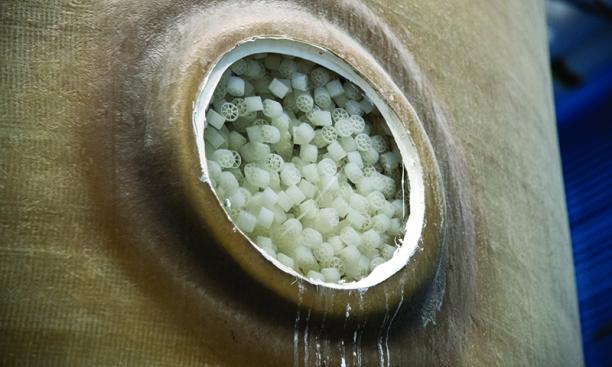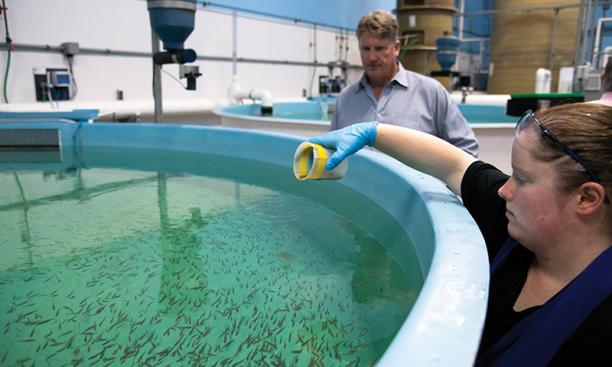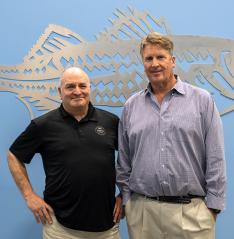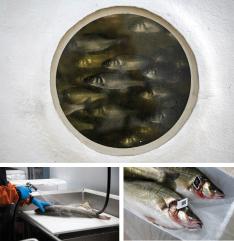One hundred fifty miles northeast of Nassau Street and 25 miles from the nearest body of salt water, Eric Pedersen ’82 is talking about fish. His fish. He is standing alongside a 27,000-gallon tank that is home to 20,000 of what he believes are the freshest, highest quality European sea bass — aka branzino — in the world.
Ninety-nine percent of the branzino in the U.S. comes from the Mediterranean Sea. Pedersen’s come from a formerly abandoned factory on a street called Avenue of Industry in Waterbury, Connecticut, where he nurtures them from the time they arrive as 0.2-gram hatchlings, the size of a small paperclip. After about a year, when the fish are about 550 grams — a little over a pound — they are taken to market.
Watch a video of Pedersen and Russell at Ideal Fish. Video by Connor Odom ’25.
When Pedersen gets going on the subject of his nascent company, Ideal Fish, he does it with the fervor of an evangelical preacher. Andy Russell ’82, his chief operating officer and friend from their years at rival eating clubs at Princeton, is not much different. All Pedersen and Russell want to do is revolutionize an industry that the Food and Agriculture Organization of the U.N. estimates to be worth $151 billion globally, prove that a land-based, sustainable fishery can be commercially viable — and forge a sea change in how Americans eat.
“We’ve never had great seafood in this country,” Pedersen says. “If you go to Europe, you see fish that are colorful and fresh. In the U.S., unless you go to a really good market, the fish are kind of gray and tired and dry. We hear a lot of Americans complain, ‘I love to eat fish as long as it doesn’t taste like fish.’ Well, the reason it tastes like fish is because it’s on the back end of its shelf life. If you get a fresh piece of fish, it doesn’t taste fishy at all. It tastes good.”
Pedersen and Russell are, to use the colloquial term, fish farmers, part of a rapidly expanding industry known as aquaculture, which, broadly defined, is the use of science to cultivate a healthy aquatic environment to support the growth of fish and marine life. Pedersen acknowledges that the industry has “a checkered past,” mostly owing to massive image problems and a sketchy track record of profitability.

If you go back to its early stages more than 30 years ago, aquaculture was widely known for its environmental recklessness, largely because some companies would descend on coastal areas, clear-cutting as needed, growing their fish and leaving behind a profoundly damaged ecosystem before moving on to a new location. Aquaculture operations would also routinely send greenhouse-gas-spewing vessels out to sea to make massive hauls of perfectly nutritious fish, only to grind them up to use as feed for their fish-farming operations. Even now, critics of aquaculture assail what they say is the excessive use of growth hormones and antibiotics in sea-cage farms in the wild.
When Pedersen began to think about starting his company, he knew the puzzle to solve was finding a way to make money while still being environmentally friendly. Ideal Fish is part of a small subset of the aquaculture world, operating what is known as a recirculating aquaculture system (RAS) — a closed-loop setup that allows for water to be filtered and reused. RAS plants are basically oversized, high-tech aquariums and they are not cheap; when commercially scaled to raise 1,000 metric tons of fish per year (a metric ton is 2,200 pounds), such installations can cost up to $25 million just for design and setup, Pedersen says. George Nardi is the VP of aquaculture service at Innovasea, a firm that designs aquaculture systems and has worked closely with Pedersen, estimates that there are only 10 to 12 land-based RAS operations in the country, though many more are under development, both in the U.S. and abroad.
“The [RAS] industry is here to stay,” Nardi says. “The question is whether [the systems] will perform as designed and will the operating teams be able to manage those farms to profitability in a way that encourages replication. We know we can do it. Now we need to prove it can be a profitable business. Eric has been a really quick study, and I’ve been terribly impressed with his passion and his persistence, but there is not a lot of precedent for what these guys are doing.”
Pedersen believes that he and Russell have established a smart, efficient template that will enable Ideal Fish to flourish where other RAS ventures have floundered. Between 70 percent and 85 percent of seafood consumed in the U.S. is imported, according to the National Oceanic and Atmospheric Administration (NOAA) fisheries report. Pedersen and Russell say that RAS technology will lower that percentage dramatically.
“What you are seeing now will eventually become the predominant method of growing fish in this country — in self-contained indoor facilities where the water and all the conditions can be optimized to create a healthier, less stressful environment for the fish,” Pedersen says. “They will grow better here in this building than they will in the wild. We are super excited. We think we’re in the right place, at the right time.”
It’s hard to say what is more improbable: that Pedersen, an architectural history major (his senior thesis was on how ancient Greek architecture reflected the evolution of political systems), has become a preeminent fish farmer; or that he is growing a species native to the Mediterranean Sea in a 63,000-square-foot former button factory in an old, struggling manufacturing town long known as the Brass City — a nod to Waterbury’s status as a leading producer of brass goods dating to the early 19th century.
“Almost all the food that Americans eat today is farmed. When was the last time you heard someone say, ‘Can I have the wild chicken?’ or ‘Can I have the wild broccoli?’”
— Linda Cornish, president and founder of Seafood Nutrition Partnership
Pedersen’s path to his place as Ideal’s founder and CEO is not as random as it might seem. Growing up in Baltimore, he enjoyed fishing in the Chesapeake Bay watershed and envisioned a career as an oceanographer; in a section about his future in his high school yearbook, he wrote two words: The Ocean. Pedersen’s interests eventually pivoted, and after getting his Princeton degree and an MBA from Wharton, he headed for Wall Street, where he spent 15 years primarily as an investment banker specializing in water filtration companies. He became convinced that, from both an environmental and commercial perspective, water filtration technology would become hugely important in ensuring an adequate supply of safe, uncontaminated water for humans and marine life alike.
Pedersen left the world of finance and took a couple of executive positions in water-filtration businesses, becoming fascinated with aquaculture and RAS along the way. Eager to ramp up his understanding of RAS, he set up two 400-gallon tanks in his basement, stocked them with branzino hatchlings, and effectively became a do-it-yourself fish farmer, an endeavor that was much more a carefully calculated experiment than a hobby. He paid close attention to what food he gave his fish and how they responded to it. He monitored their growth and overall health, tinkering relentlessly with the system. He was so obsessive about it that when he and his wife and their two kids went away on vacation, Pedersen would hire a fish nanny.
“That basement RAS was very formative in my decision to pursue the [full-scale] enterprise,” Pedersen says.
Soon Pedersen was venturing into deeper waters. He secured $10 million in funding from Pentair, a water-filtration firm that would design his RAS installation, and after he discovered a promising location at the shuttered button factory in Waterbury, found an enthusiastic supporter in the city’s mayor, Neil O’Leary. An avid fisherman who admittedly knew nothing about aquaculture, O’Leary was impressed by Pedersen’s vision and helped him get the necessary approvals from various city agencies.
“He’s a personable guy and he’s easy to work with,” O’Leary says. “After [we did] our due diligence, the city was really happy to welcome them here, and we continue to feel that way. They’ve created some jobs and created a business that’s really unique. I like the idea of having Ideal Fish in Waterbury, Connecticut. It seems to fit well with the name of the city.”
Pedersen signed a lease for the Avenue of Industry space in December 2015, with Ideal Fish breaking ground in October 2016. Pedersen opted to grow branzino, an increasingly popular fish (though still well behind salmon and shrimp, the seafood products with the largest market share in the U.S.), notably in higher-end restaurants in the Northeast. He began bringing in branzino hatchlings in the late spring of 2017, and as the business started to take off, he brought in Russell as COO in 2020 — just as the pandemic arrived and promptly sunk Ideal Fish’s business by 70 percent. A mechanical engineer who had done consulting work for Pedersen for several years, Russell previously was a senior executive at Procter & Gamble and Pepsi, specializing in overseeing cost-efficient operations.
He and Pedersen had remained in touch through the 40-plus years since they bonded as sort of eating-club adversaries, Russell joining Cottage Club and Pedersen joining Tiger Inn. The clubs delighted in pulling pranks against one another. Pedersen recalls a late-night raid by a band of Tigers who dressed up in Viking regalia, complete with horned helmets, and stormed Cottage. It was around that time that a treasured tiger sculpture in Cottage Club disappeared, never to be found. Pedersen claims to have no knowledge of the matter. “To this day, Andy still believes he will find it somewhere in my house,” Pedersen says.
Almost a quarter-century ago, Peter Drucker, management savant, economist, and visionary, reminded the world that while water may cover two-thirds of the Earth, that doesn’t mean the supply of fish is inexhaustible. “Aquaculture, not the internet, is the investment opportunity of the 21st century,” Drucker said. Between overfishing and pollution, the oceans would become increasingly imperiled, Drucker believed, heightening the importance of aquaculture. Linda Cornish, president and founder of Seafood Nutrition Partnership, a nonprofit group that promotes the consumption and health benefits of seafood, says that seafood sourced from wild capture has remained steady since the 1990s and that the growth in seafood supply is almost entirely from aquaculture.
“Seafood is the last major food category that is sourced from the wild,” Cornish says. She understands there is “a reverence” for wild-caught fish but believes that it is essential to continue to support aquaculture to meet the dietary needs of a world population that is expected to grow to 10 billion by 2050.
“We need good management practices for both wild and farm to make sure [the supply] is grown responsibly and sustainably,” Cornish says. “There are a lot of different aquaculture technologies that are in place now, [but] the biggest challenge is improving the perception of aquaculture.” Farming, Cornish insists, should not be a dirty word.
“Almost all the food that Americans eat today is farmed,” she says. “When was the last time you heard someone say, ‘Can I have the wild chicken?’ or ‘Can I have the wild broccoli?’” Cornish wants consumers to understand that aquaculture is vitally important because it is a technology that allows fish to be grown virtually anywhere in the world — even a repurposed button factory in inland Connecticut.
The principal difference between RAS and traditional aquaculture is the very recirculation that gives RAS its name. Designed to be a self-contained ecosystem, recirculating aquaculture filters and purifies the water and recycles almost all of it. Ideal’s operation, for example, has 700,000 gallons of water, 98 percent of which flows right back into its 12 tanks, with the remaining 2 percent going into the City of Waterbury’s sewage-treatment plant. All the solid waste products from the process — feces, uneaten food, mortalities, and fish trimmings — are composted and turned into fertilizer that Ideal sells to land farmers. “It’s a great circular model; the byproducts of our fish production become the nutrients for another food production system,” Pedersen says. Moreover, because Ideal fish don’t have to expend much energy to get their food (it’s right there in the tank), their feed-conversion ratio — an important metric for environmental impact — is only 1.4, meaning that Ideal uses only 1.4 pounds of feed to grow a pound of fish. Fish in the wild, having to stalk their prey, can have a feed-conversion ratio of up to 10 pounds of feed per pound of fish.
“That’s one of the biggest areas of improvement in the aquaculture [sector],” says Jessica Gephart, a professor of environmental science at American University who specializes in the study of global seafood systems.
An efficient and sustainable facility is one thing, but Pedersen knows that counts for little if his fish doesn’t taste good. By monitoring the water’s salinity, temperature, and oxygenation levels, Ideal seeks not only to replicate the environment a species of fish lives in in the wild, but to make it cleaner and healthier. If it’s possible to pamper a fish, Pedersen does it. His first hire was a marine biologist whose title is chief animal health officer. He gives his branzino top-of-the-line certified sustainable feed from an aquaculture mill in Pennsylvania.
(Ideal Fish has earned Best Aquaculture Practices designation from the Global Aquaculture Alliance, an industry group, every year it has been in business, and has been certified for its environmental sustainability by the B Corp., a nonprofit that rates companies globally for doing planetary good.)
The water in the tanks changes two to three times an hour, and waste products are filtered out. The whole plant is a biosecure facility with safeguards to protect the fish from pathogens and bacteria, including mandatory masks, gloves, and germicidal shoe baths every employee must step in before entering sensitive areas. When the baby branzino arrive, they are put in separate quarantine tanks to protect them in their early weeks and months. The facility looks as clean as the kitchen in a five-star restaurant, and with its powder-blue walls adorned with metal fish fabrications, is almost serene in its vibe.
“Our fish have a spa-like existence,” Pedersen says. “They just have one bad day.”

Apart from the installation cost of water-filtration technology, Pedersen says the biggest obstacle to profitability for RAS companies has been the use of a distributor, taking away a sizable slice of the profit margin. “People were content to grow a nice little fish and let everyone else take it to market and make all the money,” Pedersen says. Almost from the start, Ideal has done its own distribution, the sales team finding markets — for the most part restaurants in the New York-Boston corridor and select upscale stores — and then delivering to those markets.
Though he declines to divulge specific revenue figures, Pedersen says business has been robust since the pandemic began to recede. By early 2023 Ideal Fish aims to be producing 100 metric tons of branzino per year. Pedersen and Russell are eyeing another Waterbury location that is 300,000 square feet — more than five times the size of their present facility — to push their tonnage far higher. To grow their product line (and bottom line), they have partnered with a handful of sister RAS businesses around the country, enabling them to sell salmon, shrimp, barramundi, and trout under the Ideal Fish label. Ultimately, their goal is to establish a network of their own production facilities around the country.
“It makes sense both for freshness and from an environmental standpoint to locate production in the markets we serve,” Russell says.
Ideal’s core marketing pitch is that in an era when farm to table has become food industry gospel, doesn’t it make sense to offer consumers fish that comes tank to table — fish that you can trace to the source? Every Ideal branzino has a gill tag with a QR code, linking to the company website and providing its entire history, from the day it arrived in Waterbury.
“Literally, the fish we harvest today will be on a plate in a restaurant tomorrow or the day after,” Russell says.
U.s. Department of Agriculture (USDA) dietary guidelines recommend that Americans eat two 4-ounce servings of seafood per week (or 26 pounds per year), but 90 percent don’t meet that standard. The NOAA Fisheries report said that Americans consumed 19 pounds of seafood per capita annually in 2020. A similar report from the European Commission said the per capita, continent-wide seafood consumption was nearly 53 pounds. U.S. seafood consumption has remained basically level for 35 years.
“Consumption habits are very hard to change,” says Cornish, of the Seafood Nutrition Partnership. “If you didn’t grow up eating seafood, you are not going to add seafood to your diet that readily.”
An abundance of data suggests the U.S. would be a healthier country if more people followed the USDA guidelines. Pedersen can recite most of it without looking. Studies have shown that babies of mothers who eat seafood during pregnancy have an average IQ gain of 7.7 points compared with babies of mothers who do not eat seafood. For adults, fatty acids and omega 3s found in fish have been linked to improved immune-system and cognitive function and a reduced risk of heart disease, and people who eat seafood regularly are up to 20 percent less likely to suffer from depression — a fact borne out by dozens of studies over 20 years.
Benefits of eating seafood notwithstanding, Americans, on the whole, remain reluctant fish eaters. Are Pedersen and Russell swimming against the tide in a country in which many people think the two major food groups are hamburgers and hot dogs?
“The pandemic showed us that overreliance on foreign supply, from plywood to fish, is a direction we have to be moving away from,” Russell says. “I think that has begun to resonate with more and more people, not only because of the environmental side of things, but also the fact Americans should be making things for Americans.”
Pedersen adds, “What’s changed in the last 10 to 15 years is a strong consumer preference now for locally grown, sustainable seafood over what is imported into the country. When you compare a fish that’s grown in the Mediterranean to ours, that fish is a week older than ours, and just doesn’t have the mild flavor that ours has. We are winning these contests, hands down.”
Steve Costanzo, owner and chef of Olio, an acclaimed restaurant in Stamford, Connecticut, has been buying fish from Ideal almost from the time it opened.
“I use their branzino a lot, and it’s awesome,” Costanzo says. “Some people are against farm-raised fish, [but] it’s really ignorance as much as anything. It’s a very good, very clean-tasting fish. I’ve been nothing but happy with their product.”
Pedersen says he chose the company’s name because it reflects the ideals it has been built on. Yes, his mission is to grow great-tasting fish and get a somewhat reluctant American market to try it, but he says the process is no less important. He wants to grow his branzino sustainably, locally, responsibly — without growth hormones or antibiotics — in the cleanest environment possible. He wants people to trust where it comes from. A long way from Nassau Street and farther still from the Chesapeake Bay and the oceans he dreamed about as a kid, Pedersen’s aquatic orbit is now limited to 27,000-gallon tanks, and he is fine with that.




